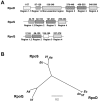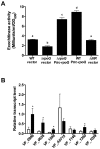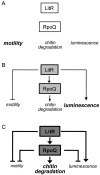The novel sigma factor-like regulator RpoQ controls luminescence, chitinase activity, and motility in Vibrio fischeri
- PMID: 22233679
- PMCID: PMC3252764
- DOI: 10.1128/mBio.00285-11
The novel sigma factor-like regulator RpoQ controls luminescence, chitinase activity, and motility in Vibrio fischeri
Abstract
Vibrio fischeri, the bacterial symbiont of the Hawaiian bobtail squid, Euprymna scolopes, uses quorum sensing to control genes involved in bioluminescence, host colonization, and other biological processes. Previous work has shown that AinS/R-directed quorum sensing also regulates the expression of rpoQ (VF_A1015), a gene annotated as an RpoS-like sigma factor. In this study, we demonstrate using phylogenetics that RpoQ is related to, but distinct from, the stationary-phase sigma factor RpoS. Overexpression of rpoQ results in elevated chitinase activity but decreased motility and luminescence, three activities associated with symbiosis. The reduction in bacterial luminescence associated with the overexpression of rpoQ occurs both in culture and within the light-emitting organ of the squid host. This suppression of bioluminescence is due to the repression of the luxICDABEG promoter. Our results highlight RpoQ as a novel regulatory component, embedded in the quorum-signaling network that controls several biological processes in V. fischeri.
Importance: Quorum signaling is a widely occurring phenomenon that functions in diverse bacterial taxa. It is most often found associated with species that interact with animal or plant hosts, either as mutualists or pathogens, and controls the expression of genes critical to tissue colonization. We present the discovery of rpoQ, which encodes a new regulatory component in the quorum-signaling pathway of Vibrio fischeri. RpoQ is a novel protein in the RpoS family of stationary-phase sigma factors. Unlike many other regulatory proteins involved in the quorum-signaling pathways of the Vibrionaceae, the distribution of RpoQ appears to be restricted to only two closely related species. The role of this regulator is to enhance some quorum-signaling outputs (motility) while suppressing others (luminescence). We propose that RpoQ may be a recently evolved or acquired component in V. fischeri that provides this organism with an additional level of regulation to modulate its existing quorum-signaling pathway.
Figures









Similar articles
-
Bacterial Quorum-Sensing Regulation Induces Morphological Change in a Key Host Tissue during the Euprymna scolopes-Vibrio fischeri Symbiosis.mBio. 2021 Oct 26;12(5):e0240221. doi: 10.1128/mBio.02402-21. Epub 2021 Sep 28. mBio. 2021. PMID: 34579565 Free PMC article.
-
HbtR, a Heterofunctional Homolog of the Virulence Regulator TcpP, Facilitates the Transition between Symbiotic and Planktonic Lifestyles in Vibrio fischeri.mBio. 2020 Sep 1;11(5):e01624-20. doi: 10.1128/mBio.01624-20. mBio. 2020. PMID: 32873761 Free PMC article.
-
Quorum sensing in the squid-Vibrio symbiosis.Int J Mol Sci. 2013 Aug 7;14(8):16386-401. doi: 10.3390/ijms140816386. Int J Mol Sci. 2013. PMID: 23965960 Free PMC article. Review.
-
Shedding light on bioluminescence regulation in Vibrio fischeri.Mol Microbiol. 2012 Jun;84(5):795-806. doi: 10.1111/j.1365-2958.2012.08065.x. Epub 2012 May 2. Mol Microbiol. 2012. PMID: 22500943 Free PMC article.
-
Lighting the way: how the Vibrio fischeri model microbe reveals the complexity of Earth's "simplest" life forms.J Bacteriol. 2024 May 23;206(5):e0003524. doi: 10.1128/jb.00035-24. Epub 2024 May 2. J Bacteriol. 2024. PMID: 38695522 Free PMC article. Review.
Cited by
-
The putative oligosaccharide translocase SypK connects biofilm formation with quorum signaling in Vibrio fischeri.Microbiologyopen. 2014 Dec;3(6):836-48. doi: 10.1002/mbo3.199. Epub 2014 Sep 25. Microbiologyopen. 2014. PMID: 25257018 Free PMC article.
-
A Master Regulator BrpR Coordinates the Expression of Multiple Loci for Robust Biofilm and Rugose Colony Development in Vibrio vulnificus.Front Microbiol. 2021 Jun 25;12:679854. doi: 10.3389/fmicb.2021.679854. eCollection 2021. Front Microbiol. 2021. PMID: 34248894 Free PMC article.
-
Discovery of a Small-Molecule Inhibitor Targeting the Biofilm Regulator BrpT in Vibrio vulnificus.J Microbiol Biotechnol. 2024 Nov 28;34(11):2201-2210. doi: 10.4014/jmb.2406.06052. Epub 2024 Sep 20. J Microbiol Biotechnol. 2024. PMID: 39403724 Free PMC article.
-
RpoS and the bacterial general stress response.Microbiol Mol Biol Rev. 2024 Mar 27;88(1):e0015122. doi: 10.1128/mmbr.00151-22. Epub 2024 Feb 27. Microbiol Mol Biol Rev. 2024. PMID: 38411096 Free PMC article. Review.
-
The cabABC Operon Essential for Biofilm and Rugose Colony Development in Vibrio vulnificus.PLoS Pathog. 2015 Sep 25;11(9):e1005192. doi: 10.1371/journal.ppat.1005192. eCollection 2015 Sep. PLoS Pathog. 2015. PMID: 26406498 Free PMC article.
References
-
- Milton DL. 2006. Quorum sensing in Vibrios: complexity for diversification. Int. J. Med. Microbiol. 296:61–71 - PubMed
Publication types
MeSH terms
Substances
Grants and funding
LinkOut - more resources
Full Text Sources
Molecular Biology Databases

